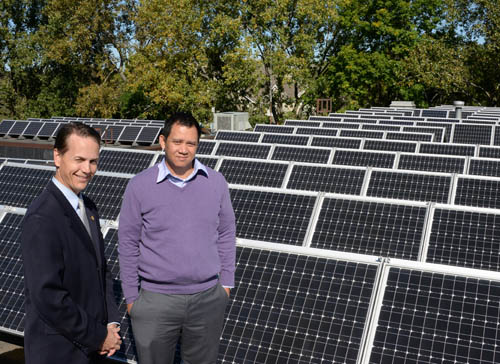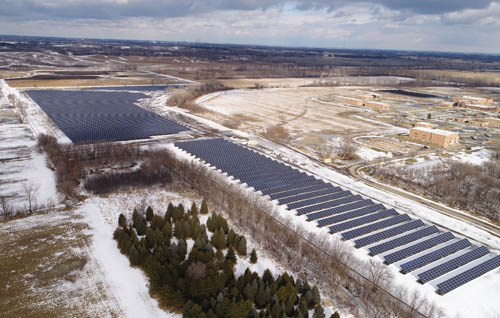
Tenacity. Strategy. Communication. Persistence.
It took two years of hard work, but a partnership of forward-thinking solar energy enthusiasts generated a Big Idea that’s now producing solar power for the electric grid.
Delivering again on its original 1967 mission “to foster efficient and economic growth for a prosperous region,” the Metropolitan Council played a central role as partner and leader helping to form the Governmental Solar Garden Subscriber Collaborative and bring the project to life.
 Falcon Heights Mayor Peter Lindstrom, one of the key project proponents, said he is very proud of the accomplishment. “The project is reducing traditional energy demand, doing good for the environment, and saving money,” Lindstrom said.
Falcon Heights Mayor Peter Lindstrom, one of the key project proponents, said he is very proud of the accomplishment. “The project is reducing traditional energy demand, doing good for the environment, and saving money,” Lindstrom said.
With 33 megawatts of power online when it opened in summer 2016, the project is reducing traditional electric demand equivalent to 5,700 homes annually.
Further, the project is a national model that can be replicated across the country.
Two years from plan to power
Lindstrom said the project began as a “meeting of the minds” in 2014 when a few of the big partners came together to learn from one another about community solar gardens, which the legislature authorized a year before.
“The Met Council and a few of the larger local governments extended the welcome mat to all local governments in the region to participate," he said. "When the invitation was made, people responded strongly. It became a coalition of the willing.”
As a regional leader, the Metropolitan Council was a natural fit in the collaboration. The project supports key long-range regional outcomes articulated in Thrive MSP 2040, most notably sustainability. The Council is reducing impacts related to climate change by leading though example and supporting local governments to address the impacts.
 The group jointly solicited competitive proposals from solar vendors who design, own and operate solar installations. That arrangement allowed local government the chance to buy solar power collectively, rather than individually going through the time-consuming procurement process to install facilities on their own property.
The group jointly solicited competitive proposals from solar vendors who design, own and operate solar installations. That arrangement allowed local government the chance to buy solar power collectively, rather than individually going through the time-consuming procurement process to install facilities on their own property.
Within a year the collaborative had attracted 31 government partners that signed up to buy a portion of the power generated at several solar installations or “solar gardens” in the seven-county area. The first two sites were located at Council wastewater treatment plants.
Much of the groundwork was handled by Council staff, including financing, technology, negotiations, procurement and contracts.
Project Manager Jason Willett said taking those burdens off local government was key to moving forward. “All local government had to do was subscribe, which was a big incentive for everyone,” he said.
“The result is financial savings for local taxpayers and ratepayers, reduced air emissions from fossil fuels, and advancements in solar production in Minnesota,” Willett said. “It’s just a big win all the way around.”
‘We’re better together’
In addition to reducing traditional energy demand and saving money, community solar gardens have produced other benefits, Lindstrom said:
-
The work has not only helped educate local government officials about energy and sustainability issues, but in turn has educated residents.
-
On a larger scale, the project has helped educate the private sector about what is possible in the future as more cooperative solar farms come on line.
“Local government is on the front line of public services – everything from repairing streets to collecting garbage to providing parks – and here again we’ve proven to be effective leaders in important ways that make our communities better,” Lindstrom said.
“We’ve proven we’re not just good environmental stewards but we also are good financial stewards. And working as a team of leaders, we’ve proven that we’re better together.”
Did you know?
1 megawatt can supply the energy needs of 174 homes for one year. Energy produced through the governmental solar garden subscriptions once all are online is expected to supply the energy needs of more than 5,700 homes annually.
Governmental Solar Garden Subscriber Collaborative
-
Steering Team: Metropolitan Council, Great Plains Institute, Hennepin County, Ramsey County, City of Minneapolis
-
31 community subscribers
-
Available power at startup: 33 megawatts in July 2016
-
Two initial sites on Council property in Carver County and Dakota County
-
Additional CSG power on tap in 2018 and beyond: 300 megawatts or more
-
Projected energy savings: Over the 25-year contract life, average community subscribers will save a total of between $350,000 and more than $1 million in energy costs depending on specific contract terms
Original Governmental Solar Garden Subscriber Collaborative Subscribers
Cities:
-
Bayport
-
Brooklyn Center
-
Burnsville
-
Chanhassen
-
Columbia Heights
-
Edina
-
Falcon Heights
-
Farmington
-
Hugo
-
Inver Grove Heights
-
Mahtomedi
-
Maplewood
-
Minneapolis
-
New London
-
Paynesville
-
Robbinsdale
-
Rogers
-
Rosemount
-
Roseville
-
St. Anthony Village
-
St. Paul
-
Stillwater
-
Waconia
Others
-
Hennepin County
-
Hennepin County Medical Center
-
Metropolitan Council Environmental Services
-
Metropolitan Council Metro Transit
-
Ramsey County
-
Saint Paul Regional Water Services
-
Three Rivers Park District
-
Washington County